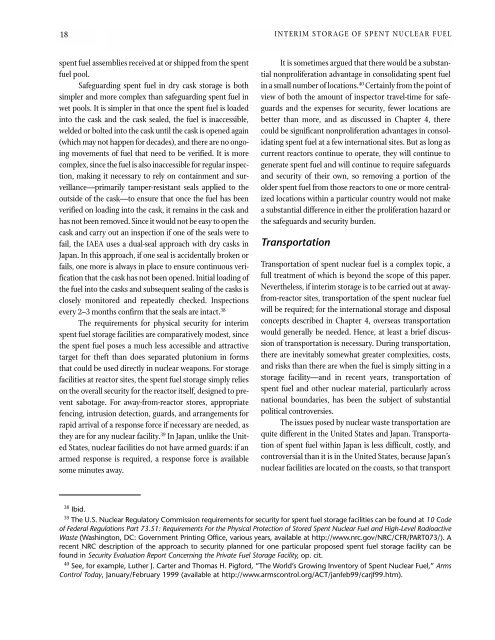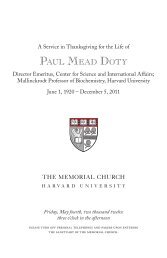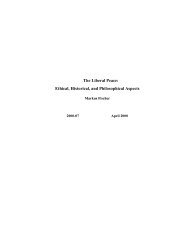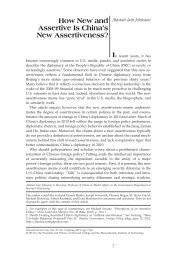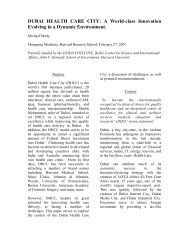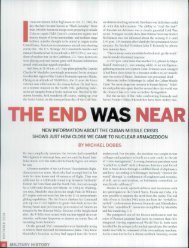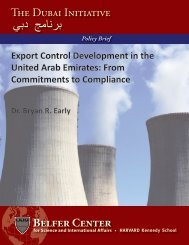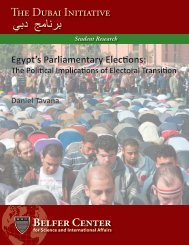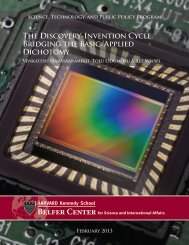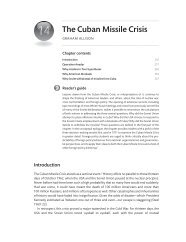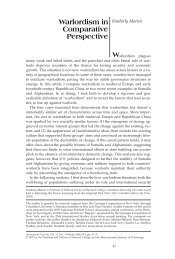Interim Storage of Spent Nuclear Fuel - Woods Hole Research Center
Interim Storage of Spent Nuclear Fuel - Woods Hole Research Center
Interim Storage of Spent Nuclear Fuel - Woods Hole Research Center
Create successful ePaper yourself
Turn your PDF publications into a flip-book with our unique Google optimized e-Paper software.
18<br />
spent fuel assemblies received at or shipped from the spent<br />
fuel pool.<br />
Safeguarding spent fuel in dry cask storage is both<br />
simpler and more complex than safeguarding spent fuel in<br />
wet pools. It is simpler in that once the spent fuel is loaded<br />
into the cask and the cask sealed, the fuel is inaccessible,<br />
welded or bolted into the cask until the cask is opened again<br />
(which may not happen for decades), and there are no ongoing<br />
movements <strong>of</strong> fuel that need to be verified. It is more<br />
complex, since the fuel is also inaccessible for regular inspection,<br />
making it necessary to rely on containment and surveillance—primarily<br />
tamper-resistant seals applied to the<br />
outside <strong>of</strong> the cask—to ensure that once the fuel has been<br />
verified on loading into the cask, it remains in the cask and<br />
has not been removed. Since it would not be easy to open the<br />
cask and carry out an inspection if one <strong>of</strong> the seals were to<br />
fail, the IAEA uses a dual-seal approach with dry casks in<br />
Japan. In this approach, if one seal is accidentally broken or<br />
fails, one more is always in place to ensure continuous verification<br />
that the cask has not been opened. Initial loading <strong>of</strong><br />
the fuel into the casks and subsequent sealing <strong>of</strong> the casks is<br />
closely monitored and repeatedly checked. Inspections<br />
every 2–3 months confirm that the seals are intact. 38<br />
The requirements for physical security for interim<br />
spent fuel storage facilities are comparatively modest, since<br />
the spent fuel poses a much less accessible and attractive<br />
target for theft than does separated plutonium in forms<br />
that could be used directly in nuclear weapons. For storage<br />
facilities at reactor sites, the spent fuel storage simply relies<br />
on the overall security for the reactor itself, designed to prevent<br />
sabotage. For away-from-reactor stores, appropriate<br />
fencing, intrusion detection, guards, and arrangements for<br />
rapid arrival <strong>of</strong> a response force if necessary are needed, as<br />
they are for any nuclear facility. 39 In Japan, unlike the United<br />
States, nuclear facilities do not have armed guards: if an<br />
armed response is required, a response force is available<br />
some minutes away.<br />
INTERIM STORAGE OF SPENT NUCLEAR FUEL<br />
It is sometimes argued that there would be a substantial<br />
nonproliferation advantage in consolidating spent fuel<br />
in a small number <strong>of</strong> locations. 40 Certainly from the point <strong>of</strong><br />
view <strong>of</strong> both the amount <strong>of</strong> inspector travel-time for safeguards<br />
and the expenses for security, fewer locations are<br />
better than more, and as discussed in Chapter 4, there<br />
could be significant nonproliferation advantages in consolidating<br />
spent fuel at a few international sites. But as long as<br />
current reactors continue to operate, they will continue to<br />
generate spent fuel and will continue to require safeguards<br />
and security <strong>of</strong> their own, so removing a portion <strong>of</strong> the<br />
older spent fuel from those reactors to one or more centralized<br />
locations within a particular country would not make<br />
a substantial difference in either the proliferation hazard or<br />
the safeguards and security burden.<br />
Transportation<br />
Transportation <strong>of</strong> spent nuclear fuel is a complex topic, a<br />
full treatment <strong>of</strong> which is beyond the scope <strong>of</strong> this paper.<br />
Nevertheless, if interim storage is to be carried out at awayfrom-reactor<br />
sites, transportation <strong>of</strong> the spent nuclear fuel<br />
will be required; for the international storage and disposal<br />
concepts described in Chapter 4, overseas transportation<br />
would generally be needed. Hence, at least a brief discussion<br />
<strong>of</strong> transportation is necessary. During transportation,<br />
there are inevitably somewhat greater complexities, costs,<br />
and risks than there are when the fuel is simply sitting in a<br />
storage facility—and in recent years, transportation <strong>of</strong><br />
spent fuel and other nuclear material, particularly across<br />
national boundaries, has been the subject <strong>of</strong> substantial<br />
political controversies.<br />
The issues posed by nuclear waste transportation are<br />
quite different in the United States and Japan. Transportation<br />
<strong>of</strong> spent fuel within Japan is less difficult, costly, and<br />
controversial than it is in the United States, because Japan’s<br />
nuclear facilities are located on the coasts, so that transport<br />
38 Ibid.<br />
39 The U.S. <strong>Nuclear</strong> Regulatory Commission requirements for security for spent fuel storage facilities can be found at 10 Code<br />
<strong>of</strong> Federal Regulations Part 73.51: Requirements For the Physical Protection <strong>of</strong> Stored <strong>Spent</strong> <strong>Nuclear</strong> <strong>Fuel</strong> and High-Level Radioactive<br />
Waste (Washington, DC: Government Printing Office, various years, available at http://www.nrc.gov/NRC/CFR/PART073/). A<br />
recent NRC description <strong>of</strong> the approach to security planned for one particular proposed spent fuel storage facility can be<br />
found in Security Evaluation Report Concerning the Private <strong>Fuel</strong> <strong>Storage</strong> Facility, op. cit.<br />
40 See, for example, Luther J. Carter and Thomas H. Pigford, “The World’s Growing Inventory <strong>of</strong> <strong>Spent</strong> <strong>Nuclear</strong> <strong>Fuel</strong>,” Arms<br />
Control Today, January/February 1999 (available at http://www.armscontrol.org/ACT/janfeb99/carjf99.htm).


